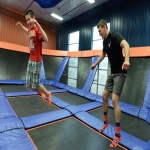
Trampolines have been keeping Orthopedics busy for decades but with the recent development of commercial jump parks that sparks the question of which is more dangerous? The results have come back and they may surprise you. We looked into a couple of reputable sites- American Academy of Orthopedic Surgeons (AAOS) and American Academy of Pediatrics (AAP).
AAOS, AAP and KCBJ all discourage recreational trampoline use; however, that does not decrease the interest, enjoyment, or injury to individuals. So, we are here to give you information, a word of caution, and a place to go if you sustain an injury.
Trampoline injuries have increased significantly from 2010 to 2014 with the emerging trampoline jump parks and that number continues to grow to this day. Most injuries are more pronounced in the lower extremity but there has also been an increase in open fractures and spinal cord injuries.

According to both AAOS and AAP the older you are the more likely you are to significantly injure yourself at a trampoline park. There’s something about getting onto the springs with friends that cause us to think we’re kids again. The old saying, “the older they are, the harder they fall” becomes very real at trampoline parks.
“In adults, fractures and dislocations accounted for 45% of jump park injuries versus 17% of home trampoline injuries.”- Journal of the AAOS
Unfortunately, this statistic does not leave children in the clear. They are still the predominant users of trampolines giving them a whopping 90% injury rate on trampolines. (OrthoInfo)

- Children younger than 6 years old should not use a trampoline.
- Allow only one person at a time on the trampoline.
- Do not depend on a safety net enclosure alone to prevent injuries; the majority of injuries actually occur on the mat of the trampoline.
- Ensure that spotters are present when participants are jumping.
- Do not allow participants to perform somersaults or other high-risk maneuvers without proper supervision and instruction. In addition, these maneuvers should never be attempted without the proper use of protective equipment, such as a harness.
- Always place trampolines at ground level; a fall from a higher surface increases the risk of injury.
- Remove trampoline ladders after use to prevent young children from climbing in and jumping without supervision.
Sources:
https://pediatrics.aappublications.org/content/early/2016/07/28/peds.2016-1236
https://orthoinfo.aaos.org/en/staying-healthy/trampoline-injury-prevention


